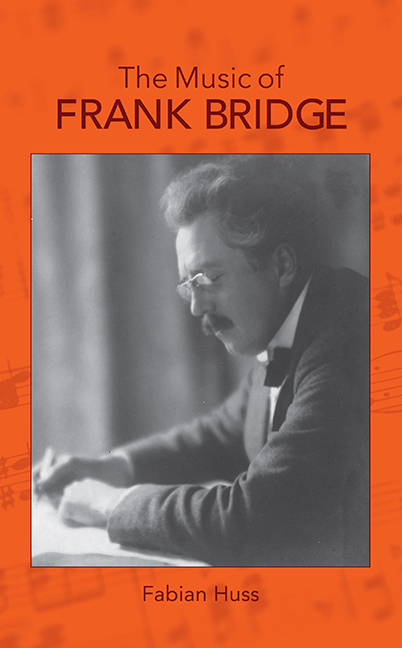Book contents
- Frontmatter
- Contents
- List of Musical Examples
- Acknowledgments
- Introduction
- Chapter 1 Background, Royal College of Music and Early Works
- Chapter 2 First Maturity
- Chapter 3 Transitional Period
- Chapter 4 Bridge’s Post-Tonal Idiom: Piano Sonata and Third String Quartet
- Interlude Elizabeth Sprague Coolidge
- Chapter 5 Progressive Works, 1927–1932
- Interlude Benjamin Britten
- Chapter 6 Last Years
- List of Works
- Bibliography
- Index
Chapter 4 - Bridge’s Post-Tonal Idiom: Piano Sonata and Third String Quartet
Published online by Cambridge University Press: 02 June 2021
- Frontmatter
- Contents
- List of Musical Examples
- Acknowledgments
- Introduction
- Chapter 1 Background, Royal College of Music and Early Works
- Chapter 2 First Maturity
- Chapter 3 Transitional Period
- Chapter 4 Bridge’s Post-Tonal Idiom: Piano Sonata and Third String Quartet
- Interlude Elizabeth Sprague Coolidge
- Chapter 5 Progressive Works, 1927–1932
- Interlude Benjamin Britten
- Chapter 6 Last Years
- List of Works
- Bibliography
- Index
Summary
TEN years elapsed between the Cello Sonata and the completion of the Third String Quartet, and in the interim Bridge finished only a single large-scale work, the Piano Sonata, on which he worked from 1921 to 1924. Although he composed several shorter pieces, scored A Prayer and sketched a substantial portion of his opera The Christmas Rose, this nevertheless represents a clear drop in productivity, which is particularly striking given that Bridge actually had more time to compose than previously, gradually abandoning his performing career and, through the patronage of Coolidge, establishing himself as a full-time composer. Since several of the basic elements of the later style had already been explored in transitional works such as the orchestral and piano Poems, his difficulties in completing the Piano Sonata and Third String Quartet (amply documented in his correspondence) do not appear to have been due primarily to the development of a new language from which to create material. Rather, the challenge lay in constituting and arranging material in a sufficiently logical way to form coherent large-scale structures, a problem that had been avoided in the shorter spans of earlier experiments. A fundamental issue was finding a balance between variety in the harmonic surface and sufficient coherence and uniformity of harmonic elements to articulate prolongational properties and hence structurally significant harmonic areas. It is noteworthy that several of the shorter works, for instance The Hour Glass, In Autumn and the three Tagore songs, did not require a comparable struggle, even though they employ a similar idiom to the Piano Sonata.
That said, the songs and piano works of the period also tend to relate back to many aspects of Bridge's established style in these miniature genres – some being more accessible in style than others – and it is interesting to note that some of the songs in particular sound strikingly English, suggesting that he had some awareness of a tradition of English song, even if it seems unlikely that he would have been attempting consciously to work in this vein. Songs such as When you are old and grey (Yeats) and Goldenhair (Joyce), for instance, inhabit a very similar soundworld to those of Gurney; others, notably the Tagore set, relate more closely to features of the contemporary piano music, and seem remote from wider trends in English song composition.
- Type
- Chapter
- Information
- The Music of Frank Bridge , pp. 126 - 152Publisher: Boydell & BrewerPrint publication year: 2015



